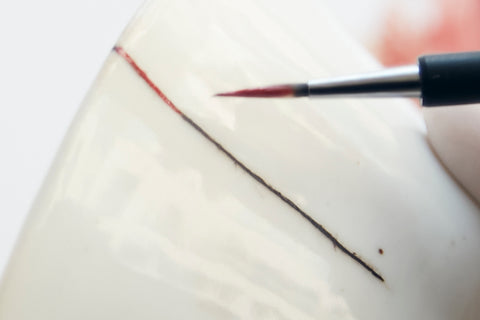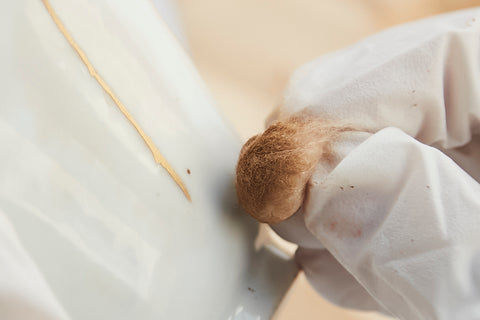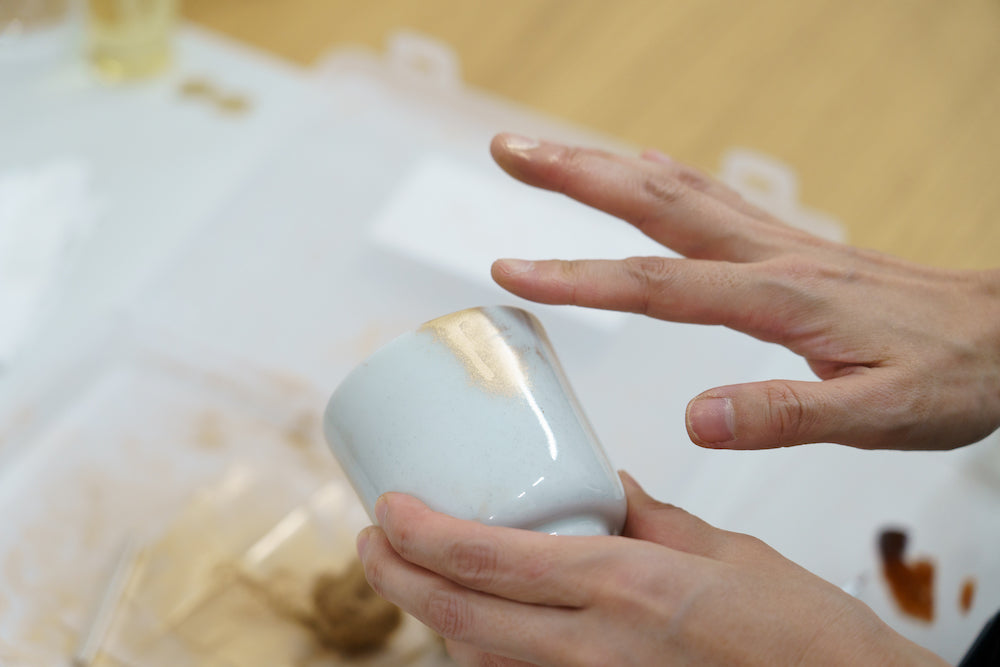Once the underlayer is completely flattened and covered with black urushi, you can go to the final step.
This article provides tips on the finishing process and answers to frequently asked questions.

Table of Contents
- The finishing process
- Ingredients of bengal-red powder
- Why is bengal-red urushi applied just before sprinkling gold powder?
- Tips for a successful finish
- I applied bengal-red urushi, sprinkled gold powder on it, and let it dry in a urushi drying chamber for a day, but it peeled right off. Why?
- Do I always have to finish with either gold or silver?
- I finished kintsugi with silver powder but can I change it to gold?
- Can I finish with copper powder?
- Is it necessary to perform the "粉固め=fun-gatame, strengthen the metal powder" process after the gold powder is sprinkled?
- Types and differences of gold powder
- FAQ
1. The finishing process

The surface of the black urushi is sanded with No.1000 waterproof sandpaper to a matte layer.
At this time, if you have sanded so much that you can see the sabi-urushi under the black urushi, redo the previous process. Apply black urushi again and allow it to dry before sanding. When only the surface of the black urushi has been sanded to a matte layer, it is time to proceed with the finishing process.
Raw urushi is refined to a caramel color and mixed with bengal-red powder to make bengal-red urushi.
bengal-red urushi is applied thinly, just before the urushi is faded, and gold powder is sprinkled on top of it using a silk ball.
You can watch this process on our YouTube tutorial video!
2. Ingredients of bengal-red powder

Bengal-red powder is made of ferric oxide (Fe2O3), a red pigment that has been used for more than 9,000 years as a coating on earthenware and is derived from clay. The color "bengal-red" comes from the oxidation of iron in the soil and the name comes from the Bengal region of India.
3. Why is bengal-red urushi applied just before sprinkling gold powder?
The ancient practice of applying bengal-red lacquer is for two reasons.
- Gold powder stands out and shines better on bengal-red layer.
- The color of the urushi must be changed between the middle and last processes. This color contrast will show where the bengal-red urushi has not been applied. If the black urushi is not completely covered with bengal-red urushi, black spots will be visible after sprinkling gold powder.
However, when finishing with silver powder, switch the color between the middle and last coat. Use bengal-red urushi for the middle coating and apply black urushi just before sprinkling silver powder. This is because silver will have better coloring on black Urushi.
4. Tips for a successful finish
(1) Apply a very thin coat of bengal-red urushi

Bengal-red urushi should be applied as thinly as possible. It should not be faded, but it is best applied very thinly.
The reason for applying a thin layer of bengal-red urushi is to put gold dust on the surface of bengal-red urushi that has almost dried. If the bengal-red urushi is thick, the sprinkled gold powder will sink into the bengal-red urushi and the surface will not look gold, but will look reddish.
If this happens, leave bengal-red urushi for some minutes or longer (the time depends on how thick you applied) after you applied, and when all the gold dust has sinked, sprinkle gold dust over it again. If it becomes reddish again, leave it for a few minutes and repeat sprinkling gold dust over it. However, this is wasteful because you will wear out more gold dust than necessary.
If bengal-red urushi is applied thickly, it is difficult to know when the surface will dry just right, so it is better to apply it thinly so that gold dust can be sprinkled right after application.
If you think you have applied the bengal-red urushi too thickly, leave it on for 10 to 30 minutes (or leave it in a urushi drying chamber) before sprinkling gold powder on it.
(2) Ensure that there is no leftover paint

Paint directly above the middle coat of black urushi. If the bengal-red urushi does not completely cover the black urushi, the black urushi will be partially visible after sprinkling gold powder. Conversely, if the bengal-red urushi is applied too widely or overflows beyond the black urushi, the bengal-red urushi cannot be removed if the vessel is unglazed. If the vessel is glazed, wipe it off immediately with a swab moistened with a small amount of ethanol, or sprinkle gold powder on it and scrape it off with a utility knife after the bengal-red urushi has dried. In any case, since this will increase unnecessary work, be sure to apply a thin, even coat of bengal-red urushi just above the middle coat.

If it takes too long time to paint the front and back of a dish with bengal-red urushi at once due to a large degree of damage or a very large bowl, you can divide the work into two parts, first painting only the front (inside) with bengal-red urushi and sprinkling gold dust, then drying it in a urushi drying chamber, and later painting the opposite side and sprinkling gold dust and drying it in a urushi drying chamber. For vessels with a large degree of damage, it is better to divide the work into two parts instead of trying to finish the work at once to reduce the risk of touching one side of the vessel with a finished coat of bengal-red lacquer by hand. However, it is better to switch at an area that is as difficult to see as possible, since the switched area can be seen when looking closely.
5. I applied bengal-red urushi, sprinkled gold powder on it, and let it dry in a urushi drying chamber for a day, but it peeled right off. Why?

The following two reasons are possible;
(1) There may have been oil on the brush, palette, or other tools, or on the vessel after the middle coat. If you touch it with your fingers, you will give oil by your hands. Urushi will not dry if oil gets mixed in, so be sure to wipe off the tools with ethanol and tissue before the finishing process to remove the oil completely.
(2) It is possible that the conditions of the urushi drying chamber were not appropriate and the bengal-red urushi did not dry completely. Please check the temperature and humidity conditions of the urushi drying chamber again (optimum temperature 20-30°C, humidity 70-85%). Then, try to leave the urushi in the urushi drying chamber for a longer period of time, not only one day, but also one week.

6. Do I always have to finish with either gold or silver?

No. You may finish with a coating of bengal-red lacquer or black urushi without metal powder. In that case, the last layer of urushi does not need to be applied thinly. It should be applied as thick as the middle coat. You may apply two or more coats of urushi at last, as several coats will make it strong. However, after applying one coat of lacquer and allowing it to dry, sand it with 1000-grit waterproof sandpaper and then apply another coat of urushi.
7. I finished kintsugi with silver powder but can I change it to gold?

Yes, you can. Sand the dried surface with 1000-grit waterproof sandpaper to remove silver powder. If the base surface is clean, you can sprinkle gold powders after applying bengal-red urushi. If the undercoat has been sanded too much or is not flat, apply another coat of middle-coat before proceeding with the finishing process. Similarly, a gold finish can be changed to silver.
8. Can I finish with copper powder?
Yes, you can. However, we do not sell copper powder. Copper is cheap, but it is prone to change the color to dark. If you do not like the color of gold because it is too bright, you can sprinkle gold powder, dry it, wash it, apply a thin layer of raw urushi, wipe it off immediately with a tissue, and dry it again in a urushi drying chamber. A thin layer of raw urushi will darken the gold color.
9. Is it necessary to perform the "粉固め=fun-gatame, strengthen the metal powder" process after the gold powder is sprinkled?

Since Tsugu kits use a type of powder called "Keshi-Powder", fun-gatame is not necessary. Fun-gatame is the process of sprinkling gold powder, drying it, applying a thin layer of raw urushi, wiping it off with a tissue, drying it again, and then polishing it. This process is done when you finish with another type of gold powder. Applying raw urushi certainly makes it a little more durable, but it darkens the gold coloration. Especially, since the keshi-powder is the thinnest and smallest of the various types of gold powders, the polishing process may cause them to rub off the powder. To make the keshi-powder more shiny, when sprinkling gold dust, do not sprinkle it on top of the bengal-red urushi as if stamping it, but stroke it gently from the side. When it is all covered with gold dust, polish it with a silk ball using very gentle force. If you use too much force, the gold dust will be removed.
10. Types and differences of gold powder

Tsugu kits use a type of powder called "keshi-powder" for both gold and silver powders. The reason for this is that the finishing process is completed simply by sprinkling the powder, making it the simplest way to complete the kintsugi process.
There are three types of metal powders commonly used in kintsugi in Japan.
(1) Keshi-powder: Smallest particles, easiest for beginners to finish
(2) Nobe-powder (also called Hiragoku-powder): Particles are of medium size, requiring fun-gatame (polishing processes) after sprinkling gold powder.
(3) Maru-powder: Largest particle size, requires fun-gatame (polishing process) after sprinkling gold powder, more durable but requires advanced techniques.

I recommend that after you are able to create perfectly beautiful kintsugi with keshi-powder, you can try maru-powder finishing, which requires highly advanced skills.
With maru-powder, the middle coating must be ultra-perfectly flat to achieve a beautiful finish. In kintsugi, the process before the final step is much more important than the final process.
11. Frequently Asked Questions
Q1. Is the bengal-red urushi in a tube the same as raw urushi mixed with bengal-red pigment?

Our Bengal-red urushi, available in a convenient tube format, serves a similar purpose to raw urushi lacquer mixed with bengal-red pigments. However, it includes a small amount of Japanese urushi. This addition improves its smoothness, making it easier to apply and less prone to brush marks. These refinements make it more expensive but highly effective for achieving professional-quality results.

After finishing a kintsugi piece, you can reflect on the importance of the former processes, saying "I should have been more careful at that time" or "I should have gone back and filled with sabi-urushi again when I noticed that it was not flat".
Therefore you start doing kintsugi on your most precious vessels, I recommend you practice with silver finish.
I’m sure anyone can do kintsugi, in the sense that it can be repaired and used again. However, if you’d like to make a beautiful kintsugi, it requires a lot of care, practice, and patience.
I hope you will continue to enjoy kintsugi!


2 comments
Hi,
Thank you for your comment.
Also, thank you for purchasing our products!
In the kintsugi process using the Tsugu Kit, silk is used during the final stage when applying gold or silver keshi-powder.
Rather than simply sprinkling the powder onto the urushi, gently rubbing the surface in circular motions with silk helps the standing powder settle, creating a smooth and glossy finish.
It’s important not to apply too much pressure, as rubbing too hard may remove the powder. Use a light and gentle touch for best results.
After sprinkling this keshi-fun (fine gold or silver powder), place the piece in the urushi drying box to dry completely.
Polishing isn’t needed afterward. To finish, gently rinse off any excess powder with water.
I hope this is helpful.
If you have any further questions, please feel free to reach out anytime!
Hi, may I please ask a question.
I have just received my order, thank you.
After finishing with gold powder. What is the best way to polish the gold ?
I do have a agate tool but when I polish with this it does not become shiny.
Do you sell a type of product for polishing gold ?
Thanks
Hon